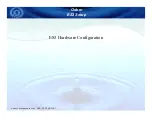
Intended Use
Obstetric (2 and 3 MHz Probes)
This product will be used to detect fetal heart beats as an aid for determining fetal viability.
Vascular (5 and 8 MHz Probes)
This product will be used to detect blood flow in veins and arteries for assisting in the detection of
peripheral vascular disease.
Caution
• U.S. Federal law restricts this device to sale by or on the order of a licensed practitioner.
Contraindications
Warnings
• The vascular probes (5 and 8 MHz) are not for fetal use.
• The ultrasound probes are not to be used on or near the eyes.
• The device is for use only on intact skin.
• Do not plug any part of this device into a telephone jack or modem system.
• This device is not intended for use simultaneously with HF surgical equipment.
If there are questions or concerns regarding these warnings or contraindications, please do not
hesitate to contact CooperSurgical for further clarification.
Caution
• Dropping the TRIA
®
II probe or accessories may cause damage to the housing or electronics.
Safety of Ultrasound
The Tria
®
II was designed with physician and patient safety in mind. In early design phases all
potential hazards were eliminated or reduced to As Low As Reasonably Achievable (ALARA) by
adhering to good design practices and industry wide safety standards. Ultrasound procedures
should be performed with the ALARA principle in mind when delivering ultrasound energy into
the body.
In order to preserve, protect and improve the quality of the environment, protect human
health and utilize natural resources prudently and rationally – do not dispose of waste
electrical or electronic equipment (WEEE) as unsorted municipal waste. Contact local
WEEE disposal sites.
I
SATA
the
spatial-average temporal-average intensity (mwatts per cm
2
).
I
SPTA.3
the
derated spatial-peak temporal-average intensity (mwatts per cm
2
).
I
SPPA.3
the
derated spatial-peak pulse-average intensity (watts per cm
2
).
MI
the
Mechanical Index.
P
r.3
the
peak rarefactional pressure
(megapascals) associated with the transmit pattern giving
rise to the value reported for MI.
W
o
the total time-average
ultrasonic power
(mwatts).
f
c
the probe
center frequency
(MHz).
Z
sp
the axial distance at which the reported parameter is measured (cm).
X
-6,
y
-6
are the –6dB beam dim. in the x-y plane where zsp is found (cm).
EBD
the
entrance beam dimensions
(cm). These dimensions are the same as the dimensions
of the transmit crystal.
Measurement Uncertainties: Power: +34, -42%
Pressure: +11, -16%
Intensity (Ispta): +23, -26%
Frequency: ± 5%
Acoustic Output Parameters are measured in water. Derated values, denoted by the subscript “.3”,
take into account a conservative level of attenuation that would be encountered in the human body.
The derated intensity values (
I
.
3
) are obtained from water values of intensity (
I
w
) at a depth of z
calculated by:
I
.3
= exp(-0.23*0.3*f*z)*
I
w
(where f is the probe frequency in MHz and z is the depth in centimeters)
The derated peak rarefactional pressure is calculated from the value of measure water (pr) by:
P
r.3
= exp(-0.115*0.3*f*z)*
p
r
(where pressure is given in megapascals)
Additional Output Reporting Information for IEC 61157
5 MHz:
I
ob
< 51 mW/cm
2
8 MHz:
I
ob
< 47 mW/cm
2
The 2 MHz, 2 MHz WP and 3 MHz obstetrical probes are exempt from the declaration requirements of
IEC 61157. These probes meet the conditions:
I
ob
< 20 mW/cm
2
,
I
spta
< 100 mW/cm
2
, and
P
r
< 1 MPa.
I
ob
is output power divided by beam area.
Note that parameter
Z
sp
in the probe reporting tables is the same parameter as
I
p
in IEC 61157.
Obstetrical Probe Information:
I
SATA (max)
(mW/cm
2
) 19.6 17.0
P
o
(mW) 48.0 24.4
Effective Radiating Area (cm
2
) 2.45 1.57
Ultrasound Frequency (MHz) 2.1 MHz 3.2 MHz
Pulse Duration CW CW
Repetition Freq. CW CW
Model Number
CTP-2 CTP-3
CTP-W
1
16




































